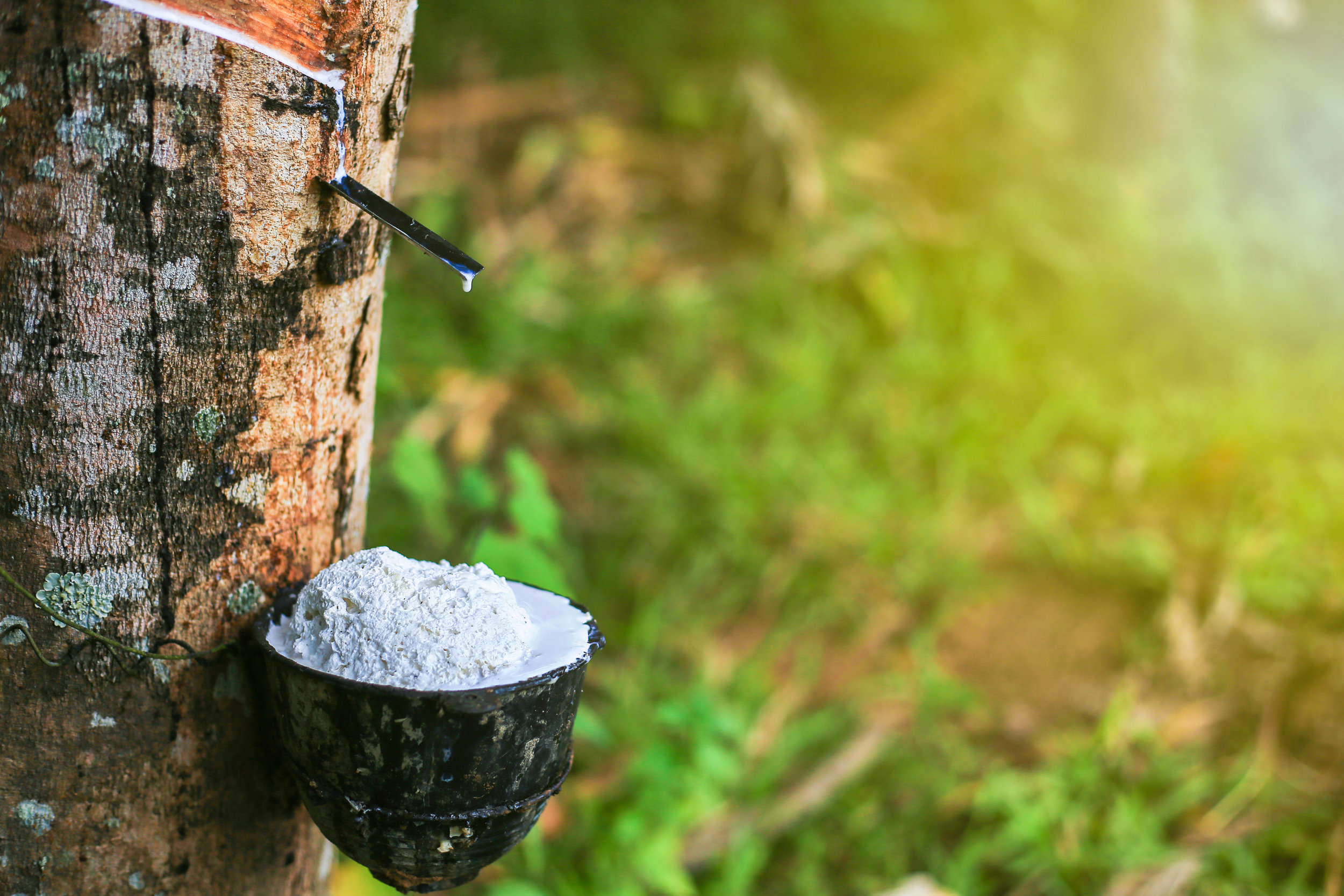Home ▸ Products ▸ Natural Rubber
Natural Rubber
Natural rubber is a derivative of Natural Latex, a white and viscous emulsion extracted from the stem of Hevea Brasiliensis. This tree requires an average temperature of 25-30°C and at least 2 meters per year of rainfall, therefore is mostly grown in the tropical and subtropical regions of Asia, Africa and South America.
Features
Thanks to the broad range of technical properties, Natural Rubber can be used in a wide variety of applications. The most consistent use is recorded in the automotive sector, particularly for the manufacturing of tires. Other uses include: clothing, gaskets, adhesives, protective coatings, piping, etc.

Harvest
The extraction from the trunk is done by tapping, the reopening at regular time intervals of a shallow diagonal incision. The latex flows from the cut along a metal spout and into a cup. Once collected, the latex can either be left to coagulate on site (cup-lump), or be transported in liquid form, to be processed later (field latex). This early selection partly determines the rubber grades that will be produced.
Types
Natural Rubber: TSR grades
Technically Specified Rubbers
Natural Rubber: RSS grades
Ribbed Smoked Sheet Rubbers
Thick Pale Crepe
Special Rubbers
Natural Rubber: TSR grades
Technically Specified Rubbers
TSR grade rubbers (Technically Specified Rubber) are classified according to their source (field latex or cup-lump) and specific technical parameters. The main exporting countries, namely Malaysia, Thailand, Vietnam and Indonesia, each produce their national standard TSR rubbers: SMR (Standard Malaysian Rubber), STR (Standard Thailand Rubber), SVR (Standard Vietnamese Rubber) e SIR (Standard Indonesian Rubber).
The TSR 10, 20, 10CV and 20CV grades, derived from cup-lump, are dark and durable rubbers, as well as the most economical TSR grades. The TSR CV50 and CV60 rubbers, produced with field latex and classified according to the Mooney viscosity scale (CV=Constant Viscosity), are light and soft rubbers, less economical due to the higher processing costs. The TSR L grade has the lightest color, classified according to the Lovibond scale.
The final product comes in the form of 33,33 kg or 35,00 kg bales, wrapped in thin or thick polyethylene (optionally) and transported in wooden crates or pallets (optionally) weighing 1,26 tons.

Natural Rubber: RSS grades
Ribbed Smoked Sheet Rubbers
In order to produce RSS grade rubbers, field latex, before reaching a complete coagulation, is processed to remove water and form sheets. After drying by smoking, the sheets are visually analyzed to determine the percentage of impurities and classified on a scale of one to five, in increasing order of impurities.
The final product is packaged in bales the size of which vary depending on the producing country.
Grades
RSS 1
RSS 2
RSS 3 / 4 / 5
Thick Pale Crepe
The particular clone of Hevea Brasiliensis growing in Sri Lanka produces a low pigment content latex. Once coagulated, the latex is processed to form sheets. After being dried without smoking, they are selected according to specific optical characteristics. The final product comes in the form of 25,00 kg or 50,00 kg bales and is transported in wooden crates or pallets (at the customer's choice) weighing 800 - 1000 kg.
Grades
TPC 1X
TPC 1
TPC 2
TPC 3 WHITE
TPC 3 YELLOW
3X BROWN
SOLE CREPE

Special Rubbers
There are other types of natural rubbers, produced by changing the polymer chains, or variations in the production process. These are produced to meet specific industrial parameters, such as: resistance to aging, resistance to chemical agents and resistance to high/low temperatures.

History
Native to the Americas, natural rubber arrives in Europe in the first half of the eighteenth century. Despite the initial interest, some technical flaws such as increased viscosity at high temperatures and high solubility, slowed down its use. It was only after countless research, attempts and failures, that around the mid-nineteenth century the versatile and resistant material known today was obtained.
1
1492
Cristoforo Colombo is the first European to observe rubber.
2
1745
Charles de la Condamine introduces rubber in Europe.
3
1770
John Priestley coined the name "rubber" (from "to rub") after observing that it could be used to erase the sign of graphite.
4
1820
Thomas Hancock invents the Masticator.
5
1839
Charles Goodyear discovers vulcanization.
6
1876
Start of the spread of the Hevea Brasiliensis in Asia.
Anecdote
At this time the natural rubber market was controlled almost exclusively by Brazil. Queen Victoria, worried about the precariousness of Brazilian supplies and in pursuit for profits, gave to the botanist Henry Wickham the assignment to go recover the rubber tree seeds in Amazonia and bring them back to England. After an adventurous journey along the Amazon River, Wickham managed to bring back home over 70,000 seeds. First planted in the Queen's gardens, they were then brought to Ceylon. The plantation trees turned out to be much more productive than the wild trees of the Amazon to such an extent that within a few years Asia invaded the market, and Brazil saw its market share go from 95% of the last decade of the nineteenth century to only 2-3% in 1913.
7
1888
John Dunlop invents the tire and begins the massive import of Natural Rubber in the west.
8
1890's
Henry N. Ridley develops "tapping", thus optimizing the extraction process which gave start to large-scale production.
9
1899
John Perkins discovers latex coagulation through the use of formic acid, further improving the production process.







